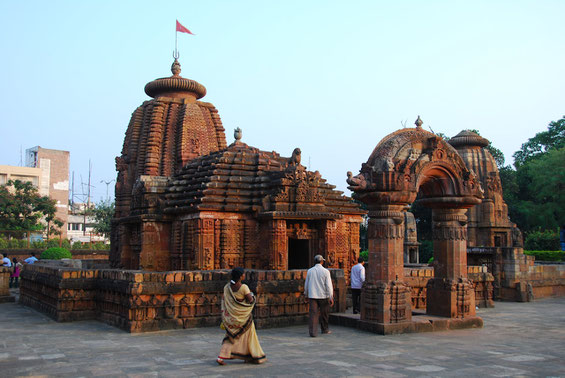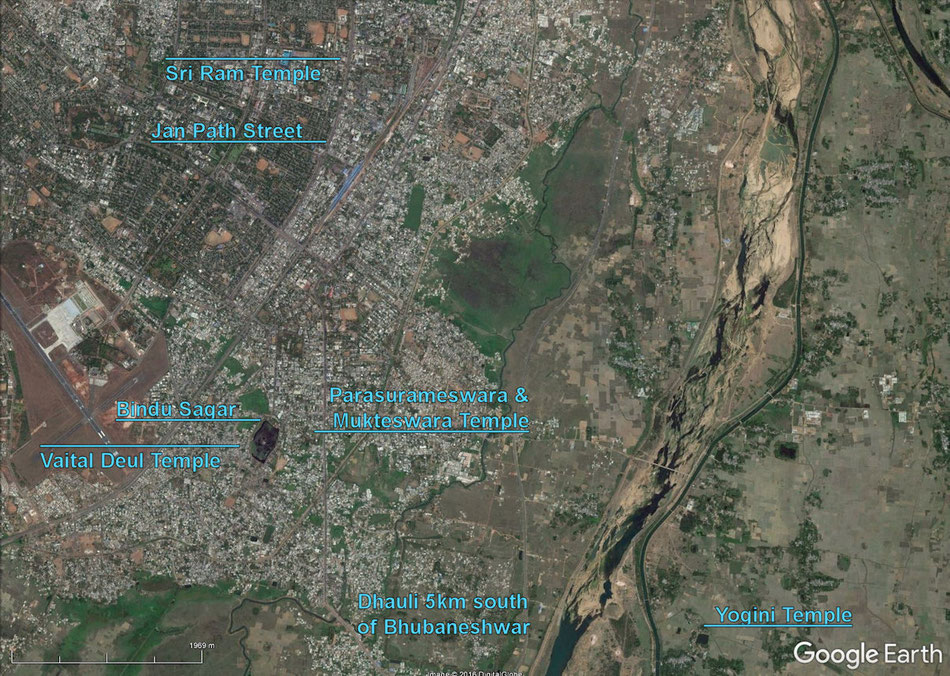India 2016 (Odisha) - Temples of Bhubaneshwar
The history of Bhubaneshwar dates back more than 2000 years.
During the reign of Ashoka, starting at 262 BCE Buddhism became the prominent religion in the Mauryan empire and was promoted in all Asia - though Ashoka also
acknowledged and accepted other religions like Hinduism, even encouraged scholarly and cultural exchange. About 50 years after his death in 232 BCE the impact of Buddhism in Odisha slowly
declined. Around 700 CE Hinduism finally prevailed though there were still some important places of Buddhist learning like Udayagiri and Ratnagiri which had influence in all Asia.
With Hinduism now beeing the dominant religion around 700 CE Bhubaneshwar became a religious centre in East India. The temple sites at Konark, Puri and Bhubaneshwar today are called the Golden Triangle. Especially the Jagannath Temple (only open to Hindus) in Puri is one of the major pilgrimage sites for Hindus in India, whereas Konark is a big hit tourist attraction.
During the climax between 700 CE and 1200 CE hundreds of Hindu temples (except one all are of the Shaiva order) were build in Bhubaneshwar alone. But when the city came under Mughal rule in 16th century most temples were destroyed, only the most important and magnificent survived.
Despite all the destruction of Hindu temples in the Mughal era there are still about 500 Hindu temples in Bhubaneshwar today. Most of them can be found in the south of the city. The oldest and most important ones are in the area around Bindu Sagar.
Shri Ram Mandir Temple
Sri Ram Mandir is a temple in the heart of Bhubaneshwar where several goods are whorshipped. There are shrines and effigies of Lord Shiva, Lord Hanuman, Lord Rama, Lord Lakshma and Goddes Sita. At time of the visit an engagement took place and the temple was not open to the public. But i was invited to stay and attend the celebrations.
Parasurameswara Temple

Build around 650 CE the Parasurameswara Temple is one of the oldest and best preserved temple in Odisha.
Some of the illustrations on the outer wall link it to a sekt which is said to have been important for the transition from Buddhism to Hinduism in Odisha in 6th century CE. And some of the reliefs emphasize superiority of Hinduism compared to Buddhism. Also it is one of the first temple with a jagamothana (assembly hall - the flat part of the building) attached to the deul (also called varma). The form of the deul itself is typical for the Odisha temple architecture in 7th century CE.
Mukteswara Temple

Just next to Parasumareswara is another important and famous temple. Dating from 10th century CE the Mukteswara Temple marks a new period of architectural temple styles.
Sometimes Parasurameswara Temple is referred to as the predecessor to Mukteswara Temple, which seems to have started a new era in terms of architecture after 200 years of development after the Parasurameswara was build. Here now the jagamohana has multiple tiers and the structure is enclosed by a wall. The torana (archway) itself is a gemstone and absolutely unique.
Only a few steps away on the same compound is another temple, called Siddhesvara Temple, which was built in early 11th century CE.
Vaital Deul Temple

Vaital Deul which was build around 800 CE is one of the oldest temples in Bhubaneshwar. It is dedicated to the goddess Chamunda. But the outer walls are also well stocked with images of other deities like Shiva, Parvati and the sun god Surya. There are also some of the oldest erotic sculptures in form of erotic couples.
Some features of the Deul, its Dravidian shape and the row of Shikaras show clear influence from southern india.
Yogini Temple

The Yogini Temple at the village of Hirapur is one of the four mayor '64 Yogini' Temples in India. Probably build in 9th century CE about 17km south east of today Bhubaneshwar, it has a completely different and unique style.
It is build as a circle without a roof, which is typical for a tantric temple where in rituals all 5 elements (earth, water, fire, sky and ether) are worshiped.
Inside of the outer wall are recesses, each containing a sculpture of a Yogini which is made of granite. In general a Yogini is the female counterpart to a male Yogi. In the context of Hindu tradition a Yogini is one of 64 sacred and incarnate females. In the Yogini Temple there is a sculpture for each Yogini, all depicted in a standing position.



























































































